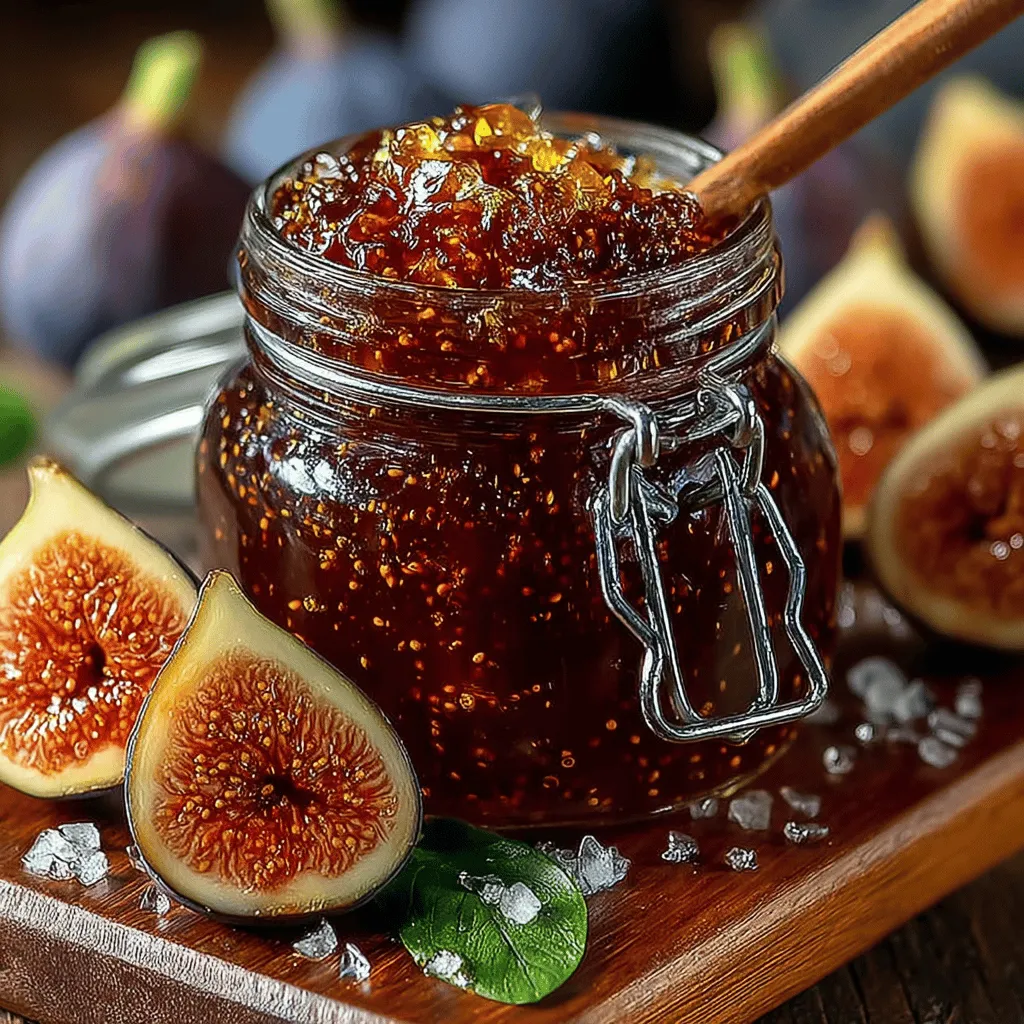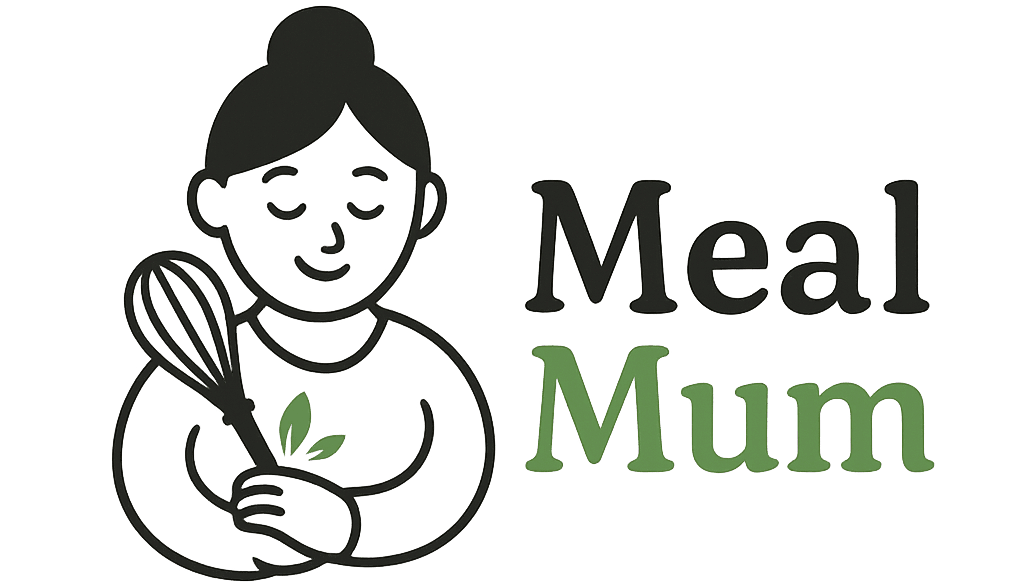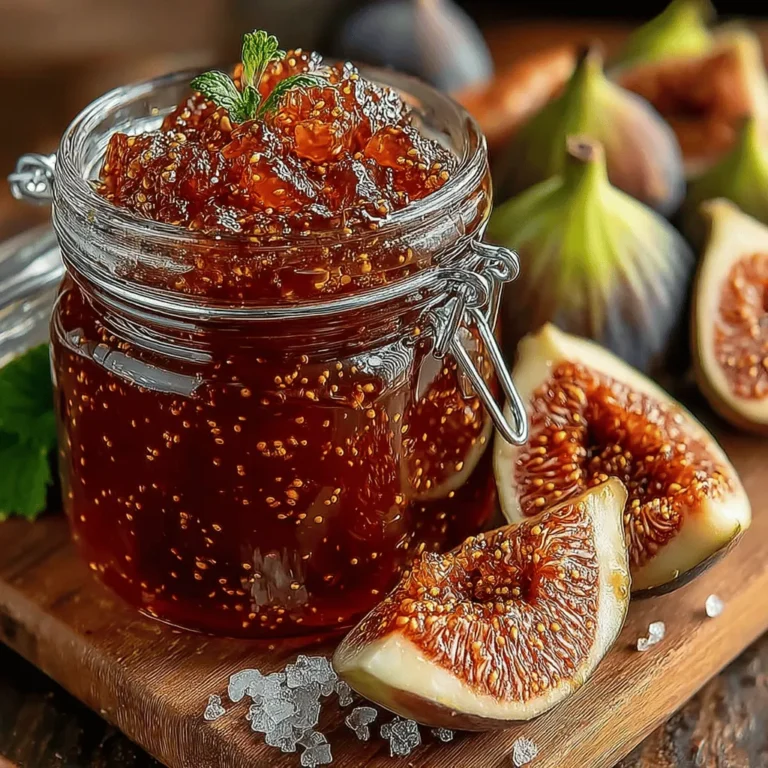Delightful Fig Jam Recipe: A Sweet Culinary Adventure
Fig jam is a delightful spread that has charmed taste buds for centuries. With its rich, sweet flavor and smooth texture, fig jam serves as a versatile condiment that can elevate a variety of dishes, from breakfast toast to gourmet cheese platters. Its popularity has surged in recent years, as more people embrace the idea of homemade preserves, seeking to capture the essence of fresh, seasonal ingredients. Unlike mass-produced options, homemade fig jam allows for a personal touch, enabling you to control the sweetness and flavor profile, ensuring a product that’s as unique as you are.
One of the essential aspects of crafting a perfect fig jam is the use of fresh ingredients. The quality of your figs will directly influence the final product, making it crucial to select ripe, flavorful fruits. With a few simple steps, you can transform these luscious fruits into a delightful spread that will impress your family and friends. Beyond its deliciousness, fig jam offers a range of culinary uses. Whether slathered on toast, dolloped on yogurt, or paired with cheese, this sweet spread can add an elegant touch to any meal.
Understanding the Ingredients
Before diving into the cooking process, it’s important to familiarize ourselves with the key ingredients that will bring this fig jam to life. Each component not only contributes to the flavor but also plays a crucial role in the preservation and texture of the final product.
*Fresh Figs*
Figs are the star of this jam, providing both taste and texture. Fresh figs are sweet, rich, and slightly chewy, making them an excellent choice for preserves. Beyond their delightful flavor, they are also packed with health benefits. Figs are a great source of dietary fiber, which aids in digestion, and they contain essential vitamins and minerals, such as vitamin B6, potassium, and calcium. When shopping for figs, look for fruits that are plump, slightly soft to the touch, and free from blemishes or mold. Ripe figs should have a sweet aroma, indicating their readiness for consumption.
*Granulated Sugar*
Sugar plays a dual role in fig jam: it not only sweetens the mix but also acts as a preservative. The sugar helps to draw out moisture from the figs, creating the desired jam-like consistency while inhibiting the growth of bacteria. When making fig jam, it’s essential to strike the right balance of sweetness to complement the natural flavor of the figs without overwhelming them. The sugar content can be adjusted based on personal preference and the sweetness of the figs used.
*Lemon Juice*
Lemon juice is another critical ingredient in fig jam, contributing necessary acidity that helps balance the sweetness of the figs. The acidity not only enhances the flavor but also aids in the preservation process by lowering the pH of the mixture. This creates an environment where harmful bacteria cannot thrive. Additionally, the bright, zesty notes of lemon juice can elevate the overall taste of the jam, providing a refreshing contrast to the rich sweetness of the figs.
*Optional Cinnamon*
For those looking to add a warm, aromatic twist to their fig jam, cinnamon is an excellent optional ingredient. The combination of figs and cinnamon creates a delightful flavor profile that evokes feelings of comfort and nostalgia. A hint of cinnamon can enrich the jam, making it an even more enticing spread for a variety of dishes.
*Water*
While water may seem like a simple addition, it plays a significant role in the cooking process. When making fig jam, a small amount of water is used to help dissolve the sugar and create a syrupy base that will later thicken as the mixture cooks. This step is crucial for achieving the desired consistency of the jam and ensuring that all ingredients are well combined.
Step-by-Step Instructions
Now that we have a solid understanding of the ingredients, let’s delve into the initial steps of making delightful fig jam. The process is straightforward and rewarding, resulting in a delicious homemade product that will elevate any meal.
*Preparing the Figs*
The first step in crafting your fig jam is to prepare the fresh figs. Begin by rinsing them gently under cool water to remove any dirt or debris. It’s essential to handle the figs with care, as they are delicate fruits that can bruise easily. After rinsing, place the figs on a clean towel to dry.
Once dried, it’s time to quarter the figs. Using a sharp knife, slice the figs into quarters, ensuring that you remove the stems. This step is crucial for achieving a smooth texture in your jam. Removing the stems not only improves the overall mouthfeel but also allows the figs to break down more easily during the cooking process.
*Combining Ingredients*
With your figs prepared, it’s time to combine the ingredients. In a large pot, measure out your quartered figs and add the granulated sugar. The amount of sugar can vary based on your taste preference and the sweetness of the figs. For a traditional fig jam, a ratio of about 1:1 (figs to sugar) is common, but feel free to adjust as needed.
Next, add freshly squeezed lemon juice to the pot. This ingredient is crucial for balancing the sweetness and providing acidity. The bright flavor of the lemon juice will enhance the figs, making your jam more vibrant. If you choose to use cinnamon, now is the time to sprinkle in a small amount, allowing those warm, aromatic notes to permeate the mixture.
Finally, add a splash of water to the pot. This will help to dissolve the sugar and create a syrupy base for the jam. Stir the mixture gently to ensure that all the ingredients are well combined before moving on to the cooking process.
With the figs and other ingredients properly prepared and combined, you are now ready to move on to the cooking phase, where the magic of transformation truly happens. Stay tuned for the next part of the article, where we will explore the cooking process in detail, ensuring your fig jam turns out perfectly every time.

Cooking the Mixture
Once your fig and sugar mixture has had time to rest and macerate, it’s time to cook it down into a luscious jam. Begin by transferring your mixture into a large, heavy-bottomed pot. This type of pot helps distribute heat evenly and minimizes the risk of burning, which can ruin your jam.
Monitoring Heat and Stirring
As you begin cooking, set your stove to medium heat. It’s crucial to keep an eye on the temperature; if it’s too high, the sugar can burn, giving your jam an unpleasant flavor. Stir the mixture frequently with a wooden spoon or a heat-resistant spatula. This constant stirring helps ensure that the ingredients blend well and prevents them from sticking to the bottom of the pot, where they might scorch.
What to Look for When the Mixture Starts Bubbling
After a few minutes, you will notice the mixture starting to bubble. This is a good sign, indicating that the sugars are dissolving and the figs are beginning to break down. Keep stirring during this initial bubbling phase, and watch closely for any signs of boiling over. If it begins to bubble too vigorously, reduce the heat slightly to maintain a gentle simmer.
Simmering
The simmering process is where the magic happens. Allow the mixture to simmer gently for about 30 to 45 minutes, stirring occasionally. During this time, the figs will soften and break down further, and the liquid will evaporate, thickening the jam.
Effects on Consistency
As the mixture simmers, you will notice a change in its appearance and thickness. The liquid will reduce, and the jam will begin to take on a more cohesive, syrupy texture. At this point, it’s important to keep stirring regularly to prevent any sticking or burning at the bottom of the pot.
Importance of Mashing Figs for Texture
For a well-balanced fig jam, you may want to mash some of the figs as they cook. Using a potato masher or the back of your spoon, gently press the figs against the side of the pot to break them down further. This will help achieve a desirable texture, combining both chunky and smooth elements in your final product.
Checking Consistency
To ensure that your jam has reached the perfect consistency, it’s important to conduct a few simple tests as the cooking time progresses.
Techniques for Testing Jam Consistency
One of the most effective methods is the plate test. To do this, place a small plate in the freezer at the beginning of the cooking process. When you think the jam is ready, take the plate out and drop a teaspoon of the jam onto it. Let it sit for about 30 seconds, then run your finger through the jam. If it holds its shape and doesn’t immediately run back together, your jam is ready to be jarred.
Desired Thickness and How to Achieve It
The desired thickness for fig jam should be similar to that of a thick syrup or a spreadable paste. If your jam is still too runny after the suggested cooking time, continue to simmer for an additional 5 to 10 minutes, and repeat the plate test until the desired consistency is reached.
Jarring the Jam
Once your fig jam reaches the right consistency, it’s time to jar it up. Before you start, ensure that your jars are clean and properly sterilized.
Best Practices for Cooling and Preparing Jars
To sterilize jars, place them in a boiling water bath for 10 minutes, then let them air dry on a clean towel. You can also run them through a dishwasher cycle without soap. Make sure your jars are completely dry before filling them with jam.
Importance of Cleanliness and Sterilization in Preserving
Cleanliness is key in preserving to prevent spoilage and ensure the longevity of your jam. Always work with clean utensils, and try to minimize direct contact with the jar openings to keep them free from contaminants.
Sealing and Storing
Now that your jars are prepared, carefully ladle the hot fig jam into each jar, leaving about 1/4 inch of headspace at the top. Wipe the rims of the jars with a damp cloth to remove any residue, then place the lids on top.
Different Methods for Sealing Jars
There are several methods for sealing your jars. You can store them in the refrigerator if you plan to use them within a few weeks. For longer shelf life, consider using a water bath canning method, where you process the jars in boiling water for about 10 minutes to create a vacuum seal.
Tips for Proper Storage and Shelf Life
When properly sealed and stored in a cool, dark place, fig jam can last for up to a year. Always check the seals before using; if a lid pops up when pressed, the jar is not sealed properly, and the jam should be refrigerated and consumed within a few weeks.
Culinary Uses for Fig Jam
Fig jam is incredibly versatile, and there are countless ways to enjoy your homemade creation.
Breakfast Ideas
Start your day on a sweet note by pairing fig jam with toast, yogurt, or pancakes. Spread it generously on warm, buttery toast or mix a spoonful into your morning yogurt for an instant flavor boost. It also goes well drizzled over pancakes or waffles, adding a delightful touch to your breakfast routine.
Savory Pairings
Fig jam is not just for breakfast! It pairs beautifully with cheese and meats. Create an elegant cheese board featuring creamy brie, tangy goat cheese, or sharp cheddar, and serve it alongside a small dish of fig jam. It also works well as a glaze for roasted meats, adding a sweet and savory dimension that enhances the dish.
Baking Applications
Incorporate fig jam into your baking repertoire. Use it as a filling for pastries, cookies, or tarts, or swirl it into cake batters for an unexpected burst of flavor. Fig jam can transform a simple dessert into a gourmet treat.
Gift Ideas
Homemade fig jam makes for a thoughtful gift. Consider packaging it in small, decorative jars, complete with labels. This makes a perfect present for special occasions like holidays, housewarmings, or as a sweet gesture for friends and family.
Conclusion
Making fig jam at home is not only a rewarding experience but also a delightful way to preserve the flavors of this exquisite fruit. The joy of crafting your own jam allows for endless possibilities in the kitchen, encouraging you to experiment with different ingredient ratios and additions.
As you explore personal variations of fig jam, such as incorporating spices or citrus, you’ll find that each batch can be uniquely yours. The satisfaction of creating homemade preserves connects us with culinary traditions and fosters a sense of pride in our cooking. So gather your ingredients, roll up your sleeves, and embark on the delicious journey of making fig jam—you won’t regret it!


